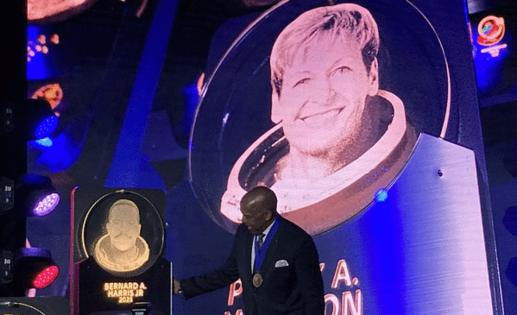Quarantined ahead of 5th trip to space, Whitson inducted with trailblazer Harris to Astronaut Hall of Fame
Published in News & Features
MERRITT ISLAND, Fla. — Four-time spaceflight veteran Peggy Whitson had a good excuse for not showing up Saturday for her own induction ceremony to the U.S. Astronaut Hall of Fame.
She’s in quarantine to go to space again.
Whitson is slated to command the private Axiom Space Ax-4 mission flying in a new SpaceX Crew Dragon spacecraft set to launch as early as June 8. So her presence at the ceremony held under the suspended Space Shuttle Atlantis at Kennedy Space Center Visitor Complex was purely virtual.
“Please know that my heart is with you. It is a privilege to be a part of such an esteemed group of individuals who have dedicated their lives to exploring the unknown,” she said in a message recorded at an undisclosed location nearby.
Fellow inductee and two-time space shuttle astronaut Bernard Harris, who became the first Black person to perform a spacewalk, was on hand, though.
He was joined by dozens of former astronauts and NASA officials as both his and Whitson’s plaques were revealed — becoming the 110th and 111th members of the hall of fame created in 1990 by the Astronaut Scholarship Foundation and represented at the visitor complex with its own building honoring inductees.
While both had significant careers with NASA, Whitson has spent a little bit more time in space — 37 times more.
Chosen as an astronaut candidate in 1996, Whitson’s first trip to space was in 2002 on Space Shuttle Endeavour on STS-111 for her first of four stays on board the International Space Station. She flew home on STS-113, also on Endeavour, and then returned twice on Soyuz missions in 2007 and 2016. She became the first female commander of the space station — and to date is its only two-time commander.
After retiring from NASA she joined private company Axiom Space and commanded its second commercial mission Axiom 2 in 2023.
The four trips have amounted to more than 675 days in space — giving her the the all-time record for women in space, as well the record for an American astronaut. That total is set to grow by another two weeks once Ax-4 is completed.
“I applied to NASA’s astronaut training program four times over nine years, and was denied. After 10 years and my fifth try of applying, I finally made it. It’s only in retrospect that I can say those years of rejection were good for me,” she said. “Those years of being refused a chance at my dream gave me an incredible experience as a leader, a builder of teams and a member of international partnerships.
“As it turned out, all of those were critical to my career as an astronaut — each mission, each spacewalk and each experiment conducted on board the International Space Station has been a step toward understanding our universe and improving life here on Earth.”
Harris was chosen as an astronaut candidate in 1990 and flew his first mission — STS-55 — on Space Shuttle Columbia in 1993 followed by STS-63 aboard Space Shuttle Discovery in 1995.
The second flight, a dress rehearsal flight for docking missions with the Russian space station Mir, wasn’t supposed to feature a spacewalk but the dominoes fell into place setting up Harris’ landmark experience.
“In truth, I didn’t know i was the first African American until I got back inside and I got the call that President Clinton wanted to talk to me,” he said. “I kind of went like, ‘What for?'”
The 68-year-old Harris born in Temple, Texas in 1956, and 65-year-old Whitson, born in Beaconsfield, Iowa in 1960, cited the Apollo 11 moonwalk by Neil Armstrong and Buzz Aldrin as their inspiration to become astronauts.
“The moon landing, when I was 9 years old, seemed to make space attainable,” Whitson said. “My 9-year-old self thought that astronaut had to be the ultimate job.
“So thanks to the moon landing, maybe even a little bit Captain Kirk and Mr. Spock, as well as my first ride in the Cessna 150 with my Dad, that spark grew into a passion for space exploration.”
Harris, who was 13 when history was made, said he wrestled with other events of the time.
“I was old enough to go through the early 60s, the civil rights movement,” he said. “I could turn one channel and see some of the greatest accomplishments of human beings at that time and turn the channel and see Blacks fighting for their right to vote or to exist depending on what part of the country that they were in.”
He said he still marvels at how his 13-year-old mind was able to meld those events together.
“I came to the conclusion that even though I didn’t see anybody who looked like me in the program — there were no women in the program, no people of color in the program that we could see … But I decided that if I didn’t see someone who looked like me I would be the first to try and go break that ceiling.”
©2025 Orlando Sentinel. Visit orlandosentinel.com. Distributed by Tribune Content Agency, LLC.







Comments